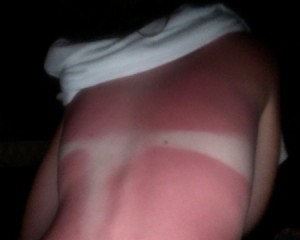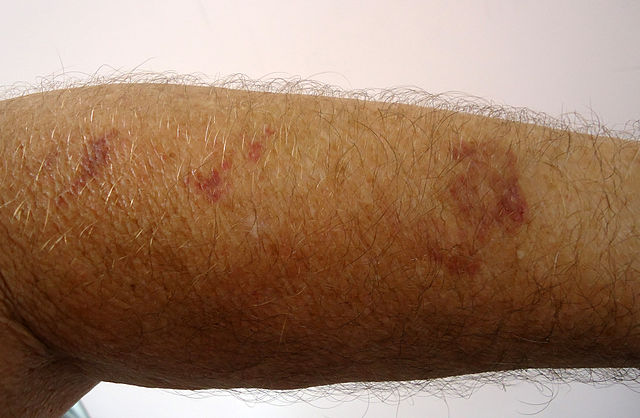Solar Purpura (Purple-Blue Patches in Sun Damaged Skin)
What is solar purpura?
Solar purpura is a condition where long term sun damage to the skin causes easy bleeding into the skin tissue with even slight injury. This appears as spots or patches of bruising that is red to purple in color. It is not the same as sunburn which is an acute skin condition due to UV light exposure. Solar purpura is a harmless condition and is not related to skin cancer which is also associated with prolonged sun exposure.
The elderly are more often affected as age-related changes coupled with prolonged sun damage weakens the blood vessels in the skin. Solar purpura is also known as actinic purpura or senile purpura due to its prevalence in seniors. It is the deeper layer of the skin, known as the dermis, which is affected. Solar purpura is often missed as a diagnosis as it takes only minimal sun exposure to cause the condition as a result of years or decades of blood vessel weakening.
Why does solar purpura occur?
Human skin is a protective barrier that is resistant to many forms of injury. With age, however, its strength and integrity is compromised. This is seen as a normal part of aging that is referred to as dermatoporosis. This is largely associated with a loss of collagen in the skin with advancing age. It is not just the skin tissue that is affected but other structures within it like the tiny blood vessels in the dermis.
The entire process of dermatoporosis is worsened with chronic sun exposure. This is one of the reasons for the more wrinkled and blemished skin of seniors who spent long hours in the sun in the early years of their life. Ultraviolet radiation in sunlight is known for a host of deleterious effects on all exposed surfaces of the body. It is usually time dependent meaning that longer hours in the sun causes greater damage.
Even moderate sun exposure particularly in a person with a lighter skin complexion can be detrimental over years and decades. As skin loses its strength and elasticity, it is no long able to provide adequate support for the tiny blood vessels in the skin.Therefore the skin is prone to damage and the blood vessels are easily ruptured.
Causes of Solar Purpura
Sun exposure
Solar purpura is caused by chronic sun exposure. Aging as well has an impact on the skin integrity. Eventually the skin is compromised to a degree that even the slightest injury will cause significant damage. Blood vessels rupture and red blood cells leak out of the blood vessel and into the skin. This gives the skin the appearance of small red patches. As the blood cells break down, the red color gradually turns into a red-purple to purple color. In time these patches may turn into a black color.

Severe sunburn
Injury
Most patients will not recall the incident that caused the injury. Due to the degree of skin weakening, the injury may have been so minor that it is not noticed at the time. The injury itself may not have initiated inflammation, a protective mechanism to limit damage. The lack of inflammation and its associated features like swelling, pain and tenderness therefore does not highlight the injury to most people. Bleeding into the skin may also not occur immediately and therefore seems unrelated to previous traumatic events.
Age
The condition affects between 10 to 12% of patients over the age of 50 years. The risk increases with advancing age and degree of sun exposure.
Medication
Although medication like aspirin and other blood thinning agents can worsen the condition, it does not cause solar purpura.
Signs and Symptoms
Patches
The darkened patches on the skin due to bleeding are medically known as ecchymoses. Initially it appears red and gradually progresses to a purple and the blue color. It may eventually turn into a black skin discoloration. These patches on the skin are typical of bruising. It is irregularly shaped and is usually greater than 3 millimeters (mm) in diameter. There is no pain or itching associated with these patches.

Picture of solar purpura (actinic purpura)
Location
The most prominent location of the solar purpura is on the extensor of the hand, commonly referred to as the top or back of the hand. The forearm is also affected to a significant degree but the patches usually do not extend to the fingers. The face and neck are other areas that are also commonly affected. It is important to note that the most prominent locations affected are the sites that are subjected to the greatest sun exposure in life.
Duration
The skin patches last for anywhere between 1 to 3 weeks after which it clears on its own even without treatment. Although this purple to black discoloration disappears, there may be a residual yellowish tinge to the skin that may last for weeks or months thereafter.
Tests for Diagnosis
There are no specific tests that are required for solar purpura. Visual examination of the skin will reveal the typical skin patches associated with bleeding into the skin. Sometimes a skin biopsy is conducted, particularly for confirming or excluding other skin problems that may co-exist. Microscopic examination tends to reveal that the skin is typically thinner than normal due to atrophy (shrinking).
Solar Purpura Complications
It is not uncommon for patients with solar purpura to be concerned about conditions like skin cancers such as malignant melanoma. Given the media attention regarding the prevalence of these conditions in lighter skinned individuals with chronic sun exposure, there is sometimes confusion regarding the link between solar purpura and skin cancer.
It is important for patients to note that solar purpura is a harmless condition and not linked to skin cancer. However, a person with chronic sun exposure is at risk of skin cancer. Although solar purpura is labeled as a benign condition, essentially meaning that it is harmless, it can cause emotional distress to patients. Women are often more concerned about the aesthetic aspect and may try a range of different treatments and products.
However, these patches usually resolve on its own and some of these treatments and products can be harsh and cause more damage to the skin which may be permanent. Although patches tend to resolve spontaneously, the formation of new patches may mean long term patchy skin discoloration.
Solar Purpura Treatment
There is no specific medical treatment that is required for solar purpura. The key is prevention.
- Tretinoin may help to reverse the skin damage associated with sunlight exposure. It cannot treat the patches that have already formed.
- Vitamin K creams may be more beneficial in treating the patches but does not prevent it from recurring.
Prevention
- Sunscreen use from early in life can prevent solar purpura. It should be continued even when a person has already developed solar purpura to limit the extent of the condition.
- Sun exposure should be limited and excessive exposure should be avoided altogether despite sunscreens providing some protection.
- Covering up the area with suitable clothing may also be helpful in limiting the sun exposure and development of new patches.
- Dry skin is more easily damaged and suitable moisturizers should also be used for maintaining healthy skin.
References
- Actinic purpura. Medscape
- Purpura. Dermnet NZ

